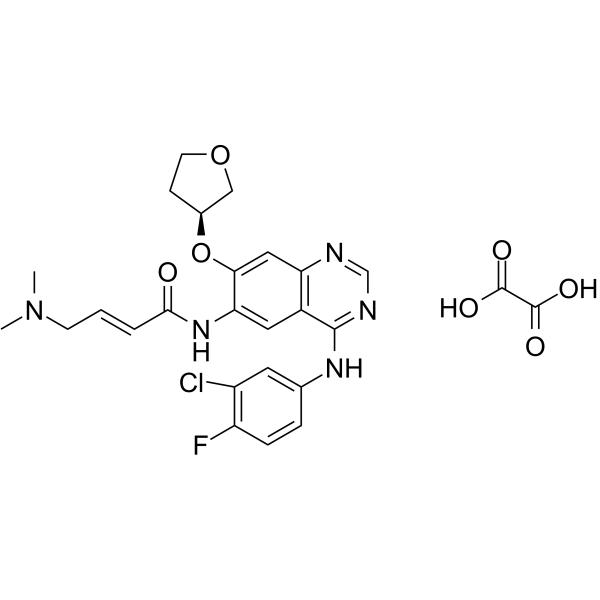Afatinib oxalate
Modify Date: 2024-04-08 19:54:38

Afatinib oxalate structure
|
Common Name | Afatinib oxalate | ||
|---|---|---|---|---|
| CAS Number | 1398312-64-5 | Molecular Weight | 575.97 | |
| Density | N/A | Boiling Point | N/A | |
| Molecular Formula | C26H27ClFN5O7 | Melting Point | N/A | |
| MSDS | N/A | Flash Point | N/A | |
Use of Afatinib oxalateAfatinib (BIBW 2992) oxalate is an orally active, potent and irreversible dual specificity inhibitor of ErbB family (EGFR and HER2), with IC50 values of 0.5 nM, 0.4 nM, 10 nM and 14 nM for EGFRwt, EGFRL858R, EGFRL858R/T790M and HER2, respectively. Afatinib oxalate can be used for the research of esophageal squamous cell carcinoma (ESCC), non-small cell lung cancer (NSCLC) and gastric cancer[1][2][3][4]. |
| Name | Afatinib oxalate |
|---|
| Description | Afatinib (BIBW 2992) oxalate is an orally active, potent and irreversible dual specificity inhibitor of ErbB family (EGFR and HER2), with IC50 values of 0.5 nM, 0.4 nM, 10 nM and 14 nM for EGFRwt, EGFRL858R, EGFRL858R/T790M and HER2, respectively. Afatinib oxalate can be used for the research of esophageal squamous cell carcinoma (ESCC), non-small cell lung cancer (NSCLC) and gastric cancer[1][2][3][4]. |
|---|---|
| Related Catalog | |
| Target |
EGFRL858R:0.4 nM (IC50) EGFRWT:0.5 nM (IC50) EGFRL858R/T790M:10 nM (IC50) HER2:14 nM (IC50) HER3 pAKT |
| In Vitro | Afatinib oxalate (100 nM) sufficiently prevents heregulin-stimulated HER3 phosphorylation[1]. Afatinib oxalate (0-10000 nM) effectively inhibits anchorage-independent proliferation of NIH-3T3 cells ectopically expressing EGFR mutants, and inhibits cell proliferation of H1666, H3255, and NCI 1975 cells[1]. Afatinib oxalate (48-72 h)shows growth inhibition in HKESC-1, HKESC-2, SLMT-1 and EC-1 cells[2]. Afatinib oxalate (0-1 μM, 24-48 h) inhibits AKT and MAPK pathways, and inhibits EGFR and AKT phosphorylation in ESCC cell lines[2]. Afatinib oxalate (0-1 μM, 16-48 h) induces G0/G1 cell cycle arrest in HKESC-2 and EC-1[2]. Afatinib oxalate (0-1 μM, 24-48 h) effectively induces apoptotic cell death in HKESC-2 and EC-1[2]. Cell Proliferation Assay[1] Cell Line: NIH-3T3 cells, H1666, H3255, and NCI 1975 cells Concentration: 0, 1, 10, 100, 1000, 10000 nM Incubation Time: Result: Effectively inhibited anchorage-independent proliferation of NIH-3T3 cells ectopically expressing EGFR mutants. Showed inhibition of anchorage independent cell proliferation of various lung cancer cell lines (H1666, H3255, and NCI 1975 cells), with IC50 values of 60 nM, 0.7 nM and 99 nM, respectively. Cell Viability Assay[2] Cell Line: HKESC-1, HKESC-2, SLMT-1 and EC-1 cell lines Concentration: Incubation Time: 48 and 72 hours Result: Observed over 95% of growth inhibition. The respective IC50 concentrations at 48 hours (HKESC-1=0.078 μM, HKESC-2=0.115 μM, KYSE510=3.182 μM, SLMT-1=4.625 μM and EC-1=1.489 μM) and 72 hours (HKESC-1=0.002 μM, HKESC-2=0.002 μM, KYSE510=1.090 μM, SLMT-1=1.161 μM and EC-1=0.109 μM) were all in lower micro-molar range. Western Blot Analysis[2] Cell Line: HKESC-2 cells and EC-1 cells Concentration: 0, 0.01, and 0.1 μM (HKESC-2 cells), 0, 0.1 and 1 μM (EC-1 cells) Incubation Time: 24 and 48 hours Result: Reduced the phosphorylation of EGFR and the endogenous expression level of HER2 receptors in ESCC cells. Suppressed AKT phosphorylation in a dose and time dependent manner. Significantly reduced the phosphorylation level of the downstream effectors of the AKT-mTOR axis especially in HKESC-2 cells. Inhibited the two major downstream pathways of the ErbB/HER axis, namely, AKT and MAPK pathways in ESCC cell lines. Cell Cycle Analysis[2] Cell Line: HKESC-2 cells and EC-1 cells Concentration: 0, 0.01, and 0.1 μM (HKESC-2 cells), 0, 0.1 and 1 μM (EC-1 cells) Incubation Time: 16, 24, and 48 hours Result: Induced G0/G1 cell cycle arrest in both tested ESCC cell lines in a time and dose dependent manner. In HKESC-2 cells, the percentage of cells in G0/G1 phase was increased from 38.2% to 68.1% at 0.01 μM of afatinib and to 74.7% at 0.1 μM of afatinib, from 24 hours (82.4% G0/G1 arrest at 0.01 μM and 86.2% at 0.1 μM) to 48 hours (from 74.7% to 88.2% for 0.01 μM and 91.0% for 0.1 μM). In EC-1 cells, the percentage of cells arrested in the G0/G1 phase was increased from 59.1% to 66.6% and 72.2% at 24 and 48 hours respectively. Apoptosis Analysis[2] Cell Line: HKESC-2 cells and EC-1 cells Concentration: 0, 0.01, and 0.1 μM (HKESC-2 cells), 0, 0.1 and 1 μM (EC-1 cells) Incubation Time: 24 and 48 hours Result: Effectively induced cell death by triggering apoptotic mechanisms in ESCC cell lines. Showed a stronger expression level of cleaved Poly (ADP-ribose) polymerase (PARP) in these cell lines. |
| In Vivo | Afatinib oxalate (0-20 mg/kg, Orally, daily for 25 days) shows dramatic tumor regression and downregulation of EGFR, HER2, HER3 and AKT phosphorylation[1]. Afatinib oxalate (15 mg/kg, Orally, in a schedule of 5 days on plus 2 days off, for two weeks) strongly inhibits the growth of HKESC-2 tumor[2]. Animal Model: Athymic NMRI-nu/nu female mice (21–31 g, five to six-week-old, transgenic murine lung cancer model and xenograft models)[1] Dosage: 15 mg/kg, 20 mg/kg Administration: Orally, daily for 25 days Result: Resulted in dramatic tumor regression with a cumulative treated/control tumor volume ratio (T/C ratio) of 2% in a standard xenograft model of the epidermoid carcinoma cell line A431, and downregulation of EGFR and AKT phosphorylation. Induced regression of large tumors in this HER2-driven model, effectively controlled xenograft tumor formation by the NCIH1975 cell line, expressing EGFR L858R/T790M, with a T/C value of 12% for doses of 20 mg/kg. Induced more than 50% percent tumor reduction after a 4-week treatment period. Downregulated EGFR, HER2 and HER3 phosphorylation. Animal Model: Six weeks old female athymic nude mice (nu/nu) (16-20 g)[2] Dosage: 15 mg/kg Administration: Oral gavage in a schedule of 5 days on plus 2 days off, for two weeks Result: Strongly inhibited the growth of HKESC-2 tumor. Average tumor sizes of vehicle and treatment at end point are 348 ± 24 mm3 and 108 ± 36 mm3 respectively. |
| References |
| Molecular Formula | C26H27ClFN5O7 |
|---|---|
| Molecular Weight | 575.97 |